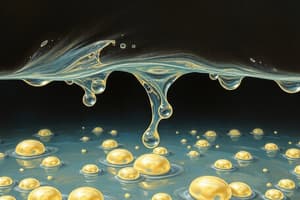Podcast
Questions and Answers
What role do surfactants play in emulsification processes?
What role do surfactants play in emulsification processes?
They reduce surface tension between two substances, such as oil and water.
Amphiphilic substances contain both hydrophobic and hydrophilic regions.
Amphiphilic substances contain both hydrophobic and hydrophilic regions.
True (A)
Phospholipids have a hydrophobic head and two hydrophilic tails.
Phospholipids have a hydrophobic head and two hydrophilic tails.
False (B)
Surfactants are amphiphilic molecules that increase surface tension between two substances.
Surfactants are amphiphilic molecules that increase surface tension between two substances.
Proteins do not have amphiphilic regions that play a role in their interactions with cellular membranes.
Proteins do not have amphiphilic regions that play a role in their interactions with cellular membranes.
Lipid bilayers are the structural basis of cell membranes, providing a selectively permeable barrier.
Lipid bilayers are the structural basis of cell membranes, providing a selectively permeable barrier.
Micelles are typically larger, spherical structures formed in a solution, often used for solubilizing hydrophobic substances.
Micelles are typically larger, spherical structures formed in a solution, often used for solubilizing hydrophobic substances.
Liposomes, which are vesicles with a lipid bilayer, are not used as carriers for drug delivery.
Liposomes, which are vesicles with a lipid bilayer, are not used as carriers for drug delivery.
Both micelles and bilayers are structures formed by amphiphilic molecules in response to the hydrophilic effect.
Both micelles and bilayers are structures formed by amphiphilic molecules in response to the hydrophilic effect.
Micelles have a planar, sheet-like structure.
Micelles have a planar, sheet-like structure.
The hydrophilic heads in a micelle are oriented inward toward the core of the structure.
The hydrophilic heads in a micelle are oriented inward toward the core of the structure.
Lipid bilayers are formed by arranging amphiphilic molecules into two layers.
Lipid bilayers are formed by arranging amphiphilic molecules into two layers.
Micelles are generally large structures with a size in the micrometer range.
Micelles are generally large structures with a size in the micrometer range.
Flashcards are hidden until you start studying




